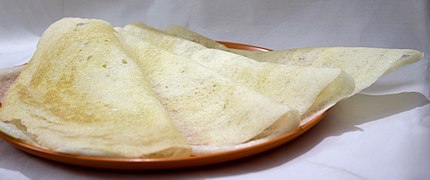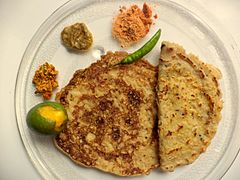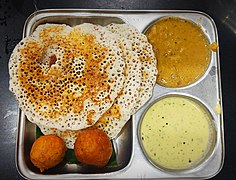Dosa (food)
 | |
| Type | Pancake, crepe |
|---|---|
| Place of origin | India |
| Region or state | South India |
| Serving temperature | Hot |
| Main ingredients | Rice and Urad dal |
| Variations | Plain dosa, Masala dosa, rava dosa, ghee roast dosa, neer dosa, butter dosa and many more. |
A dosa / dosai / dosey / dosha is a thin batter-based dish (usually plain) originating from South India[1][2] made from a fermented batter predominantly consisting of lentils and rice. Its main ingredients are rice and urad dal, ground together in a fine, smooth batter with a dash of salt, then fermented. Dosas are a common dish in South Indian cuisine[1] but are now popular all over the Indian subcontinent. Dosas are served hot along with chutney by tradition and sambar in recent times.[3][4] Davanagere benne dose, or butter dosa, is prepared by adding a generous amount of butter while preparing plain dosa or masala dosa.[5][6][7]
History


Dosas originated in South India; their exact birthplace in that region is a matter of conjecture. According to historian P. Thankappan Nair, dosa originated in the Udupi town of present-day Karnataka.[8][2][9]However, according to food historian K. T. Achaya, references in the Sangam literature suggest that dosa (as dosai) was already in use in the ancient Tamil country around the 1st century.[10] Achaya states that the earliest written mention of dosa appears in literature of present-day Tamil Nadu, in the 8th century, while the earliest mention of dosa in the Kannada literature appears a century later.[11][12]
In popular tradition, the origin of the dosa is linked to Udupi town it associated with Udupi cuisine[13] Also, the Tamil dosai is softer and thicker. The thinner and crispier version of dosa was first made in present-day Karnataka.[14][1] A recipe for dosa (as dosaka) can be found in Manasollasa[1] a 12th-century Sanskrit encyclopedia compiled by the Chalukya king Someshvara III, who ruled from present-day Karnataka.[15]
After the Independence of India, South Indian cuisine became gradually popular in the North. In Delhi the Madras Hotel[16] in Connaught Place became a landmark that was one of the first restaurants to serve South Indian cuisine.[17] It arrived in Mumbai with the Udupi restaurants in the 1930s.[18]
Names


Dosa is the anglicised name of a variety of South Indian names for the dish, for example dosai in Tamil, dose in Kannada and dosha in Malayalam.
The standard transliterations and pronunciations of the word in various South Indian languages are as follows:
| Language | Transliteration | Pronunciation (IPA) |
|---|---|---|
| Template:Lang-kn | dōsé | [d̪oːseɪ] |
| Template:Lang-ml | dōśa | [d̪oːɕa] |
| Template:Lang-ta | tōsai | [t̪oːsʌj] |
| Template:Lang-te | dōsa | [d̪oːɕʌ] |
Nutrition
Dosa is high in carbohydrates and contains no added sugars or saturated fats. As its key ingredients are rice and black gram, it is also a good source of protein.[19] One homemade plain dosa without oil contains about 112 calories, of which 84% is carbohydrate and 16% protein.[20] The fermentation process increases the vitamin B and vitamin C content.[21]
Preparation
A mixture of rice and black or green gram that has been soaked in water is ground finely to form a batter. Some add a bit of soaked fenugreek seeds. The proportion of rice to lentils is generally 3:1 or 4:1. The batter is allowed to ferment overnight, before being mixed with water to get the desired consistency. The batter is then ladled onto a hot tava or griddle greased with oil or ghee. It is spread out with the base of a ladle or bowl to form a pancake. It can be made either to be thick like a pancake, or thin and crispy. A dosa is served hot, either folded in half or rolled like a wrap. It is usually served with chutney and sambar. The mixture of black grams and rice can be replaced with highly refined wheat flour or semolina.
-
Rice batter
-
Batter poured on a tava or griddle
-
Batter being spread uniformly
-
After being cooked for some time
Serving
Dosa can be stuffed with fillings of vegetables and sauces to make a quick meal. They are typically served with a vegetarian side dish which varies according to regional and personal preferences. Common side items are:
- Sambar
- Chutney
- Idli podi or milagaipodi: a lentil powder with spices and sometimes desiccated coconut, mixed with sesame oil or groundnut oil or ghee
- Indian pickles
Variations
Masala dosa is a type of dosa that contains a potato masala filling. Mysore masala is the spicier version of it. Saada (plain) is without filling; paper dosa is a thin and crisp version. Rava dosa is made crispier using semolina.[22] Newer recipes have been developed that are fusions such as Chinese dosa, cheese dosa, paneer dosa, pizza dosa and many more.[23]
Though dosa typically refers to the version made with rice and lentils, many other versions exist.[citation needed]
| Name | Key ingredients |
|---|---|
| Masala dosa | spiced potatoes tucked inside the dosa with red chutney smeared over the dosa. |
| Oats dosa | healthy, crisp and lacy instant dosa made with oats. |
| Wheat dosa | dosa made with wheat flour batter. |
| Set dosa | very spongy, soft and light, served in a set of 3 dosa per serving.[24] |
| Plain dosa | Dosa served with only chutney and sambar and no filling. |
| Ghee roast | (Nei Dosai in Tamil) Plain Dosa cooked with Ghee instead of oil and usually with no filling. |
| Egg dosa | (Muttai Dosai in Tamil) A thicker base of Dosa topped with beaten egg, or beaten egg is added to batter before cooking. |
| KaRi dosai | A Tamil Nadu specialty with a dosa of thicker base topped with cooked meat, usually chicken or mutton. |
| Paneer dosa | spiced paneer filling inside the dosa. |
| Palak dosa | layered with palak (spinach) paste inside the folds of dosa. |
| Mini soya dosa[25] | soya milk and wheat flour[26] |
| Pesarattu (green dosa)[27] | green gram[28] |
| Adai dosa | From Tamilnadu a dosa-like dish prepared from a combination of toor dal, rice, curry leaves, red chillies and asafoetida. The batter is not fermented. Usually eaten with jaggery or aviyal. |
| Light white dosa | rice and coconut[29] |
| Kadapa karam dosa[30] | Rice flour fermented overnight and mixed with sodium carbonate. The topping is a mixture of onion and chili paste (called yerra karam) and a chutney made with tomato and flour made in a gravy of curd. It is also occasionally topped with fried gram powder.[30] |
| Mysore masala dosa[31] | rice, black gram, fenugreek seeds |
| Onion rava dosa[32] | Semolina, rice flour,onion |
| Ragi wheat dosa | Ragi, whole wheat flour[33] |
| Rava dosa | rava or sooji[34] (semolina) |
| Benne dose | butter ('benne' in Kannada) ('vennai' in Tamil)
Predominantly famous as "Davanagere benne dose" associated with Davanagere district in Karnataka. |
| Neer dosa | watery rice batter |
| Vodu dose or Kappa roti | Vodu dose or Kappa roti is made from rice, fenugreek seeds, grated coconut, thinly flattened rice and sometimes leftover cooked rice is also added.
It is non fermented type of dosa. It is cooked on an earthen pan that has a rounded bottom. It is fluffy and appears like a bread. It is cooked without the use of oil. |
| Amboli, ghavan, dhirde | In coastal parts of Maharashtra, variations known as amboli, ghavan and dhirde (or dhirade) exist. Amboli and ghavan (like dosa) are thin rice crêpes prepared with fermented batter, while dhirde is prepared with unfermented batter. |
| Buttermilk dosa | Semolina, maida, buttermilk[35] |
| Jaggery dosa | Rice flour, maida, grated coconut, jaggery |
| Garlic cheese Dosa | Plain Dosa with thinly chopped garlic,coriander and grated cheese as a filling |
-
Masala dosa served traditionally with chutney, sambar, sauteed potato filling
-
Uttapam is one of the many varieties of dosa prepared in India and served for breakfast.
-
Urad plain dosa
-
Wheat flour dosa
-
Plain dosa
-
Paper roast, a wafer-thin crispy dosa, served in restaurants
-
Ghee roast
-
Butter dosa, known as benne dose in Karnataka. Predominantly famous as "Davanagere benne dose" associated with Davanagere district.
-
Pesarattu (moong dal dosa) and ginger chutney in Andhra Pradesh
-
Mangalorian neer dosa popular in South Canara districts, Karnataka
-
Kambu (bajra/pearl millet) dosa
-
Rava dosa made from sooji rava flour, more popular in Karnataka and Udupi restaurants in Mumbai
-
Godi mau dosa (wheat dosa)
-
Ragi dosa made of ragi flour mixed with small portions of rice and urad dal
-
Uthappam or utthapa, a version with onion, chilli and tomato
-
Methi dosa on a pan, known as vendhyam dosai in Tamil Nadu
-
Masala dosa at a street food center in Bengaluru
-
"Table dosa" which covers almost half of the table
-
Indian street dosa masala in Varanasi, India
-
Onion dosa, with coconut chutney and aloo curry
-
Set dosa, a set of 3 dosas with coconut chutney, curry and Mysore Bajji
Masala dosa

Masala dosa is made by stuffing a dosa with a lightly cooked filling of potatoes,[36] fried onions and spices. The dosa is wrapped around an onion and potato curry or masala.
Related foods
- Uttapam: a dosa-like dish made from the same batter. Unlike a dosa, which is crisp and unlike relatively soft crepes, it is a thick pancake mostly topped with diced onions, tomatoes, cilantro or cheese. Uttapam is sometimes characterized as an Indian pizza.
- Pesarattu: in Andhra Pradesh, a dosa-like preparation prepared from green gram, which is typically served with a ginger and tamarind chutney
- Adai: From Tamilnadu a dosa-like dish prepared from a combination of toor dal, rice, curry leaves, red chillies and asafoetida. The batter is not fermented. Usually eaten with jaggery or aviyal.
- Appam/aappam/hopper: a pancake prepared from a combination of patted rice batter. The center is thicker and the outer rim is very thin. Served with sweet coconut milk.
- Chakuli pitha: batter contains more black gram and less rice flour
- Apam balik: made from a mixture of flour, eggs, sugar, baking soda, coconut milk and water.
- Jianbing: dosa-like dish made in China
- Bánh xèo: a dosa-like dish made in Vietnam.
- Chebab: a Middle Eastern rice pancake
- Injera: an Ethiopian dish made with fermented batter of teff
See also
- List of fermented foods
- List of Indian breads
- List of pancakes
- Mangalorean cuisine
- Udupi cuisine
- Tamil cuisine
- Cuisine of Kerala
References
- ^ a b c d Nair, P. Thankappan (2004). South Indians in Kolkata: History of Kannadigas, Konkanis, Malayalees, Tamilians, Telugus, South Indian Dishes, and Tippoo Sultan's Heirs in Calcutta. Punthi Pustak. ISBN 978-81-86791-50-9.
- ^ a b Achaya, K. T. (November 2003). The Story of Our Food. Universities Press. ISBN 978-81-7371-293-7.
- ^ Nair, P. Thankappan (2004). South Indians in Kolkata: History of Kannadigas, Konkanis, Malayalees, Tamilians, Telugus, South Indian Dishes, and Tippoo Sultan's Heirs in Calcutta. Punthi Pustak. ISBN 978-81-86791-50-9.
- ^ "Asia Times Online - The best news coverage from South Asia". web.archive.org. 2 February 2004. Retrieved 26 July 2022.
- ^ "Benne Dosa (Butter Dosa)". The Indian Food Court. 27 August 2010. Retrieved 26 July 2022.
- ^ Mujumdar, Neha (22 December 2012). "In search of DAVANGERE BENNE DOSE". The Hindu. ISSN 0971-751X. Retrieved 26 July 2022.
- ^ "Simple Indian Food- An Easy Cooking Blog: Davangere Benne Dosa". Simple Indian Food- An Easy Cooking Blog. Retrieved 26 July 2022.
- ^ P. Thankappan Nair (2004). South Indians in Kolkata. Punthi Pustak. p. 320. ISBN 81-86791-50-7.
- ^ "Asia Times Online - The best news coverage from South Asia". web.archive.org. 2 February 2004. Retrieved 26 July 2022.
- ^ K. T. Achaya (November 2003). The Story of Our Food. Universities Press. p. 80. ISBN 81-7371-293-X.
- ^ Charmaine O' Brien (15 December 2013). The Penguin Food Guide to India. Penguin Books Limited. p. 378. ISBN 978-93-5118-575-8.
- ^ Achaya, K. T. (November 2003). The Story of Our Food. Universities Press. ISBN 978-81-7371-293-7.
- ^ "Asia Times Online - The best news coverage from South Asia". web.archive.org. 2 February 2004. Retrieved 28 July 2022.
- ^ Vir Sanghvi (1 January 2004). Rude Food: The Collected Food Writings of Vir Sanghvi. Penguin Books India. pp. 109–110. ISBN 978-0-14-303139-0.
- ^ K.T. Achaya (2003). The Story of Our Food. Universities Press. p. 85. ISBN 978-81-7371-293-7.
- ^ Bride at Ten, Mother at Fifteen: Autobiography of an Unknown Indian Woman, Sethu Ramaswamy, Namita Gokhale Editions, 2003, ..in 1942 and stayed in the Madras Hotel in Connaught Place
- ^ Much Ado Over Coffee: Indian Coffee House Then And Now, Bhaswati Bhattacharya, Routledge, 2017
- ^ 8 oldest Udupi restaurants in Mumbai
- ^ Srilakshmi, B. (2006) [2002]. Nutrition Science (Revised 2nd ed.). New Age International (formerly Wiley Eastern Ltd.). p. 403. ISBN 978-81-224-1633-6. Retrieved 22 May 2011.
- ^ "Calorie Chart, Nutrition Facts, Calories in Food | MyFitnessPal | MyFitnessPal.com". www.myfitnesspal.com. Retrieved 7 May 2019.
- ^ Nutrition and Dietetics - Higher Secondary - First Year (PDF). Directorate of School Education, Government of Tamil Nadu. 2004. p. 31. Archived from the original (PDF) on 21 March 2012. Retrieved 30 August 2012.
- ^ A Beginner’s Guide to the Great Wide World of Indian Dosa, Priya Krishna and Shailendra Krishna, October 6, 2016
- ^ A Dosa Lesson From a Professional - A Good Appetite, Melissa Clark, New York Times, 6 October 2017
- ^ "Set Dosa Recipe from Udupi". Udupi-Recipes. 9 December 2013. Retrieved 9 January 2020.
- ^ "Recipe: Mini soya dosa". The Times of India.
- ^ "Mini Soya Dosa". food.ndtv.com.
- ^ "Healthy snack recipe: Green Dosa". The Times of India.
- ^ "Pesarattu (Green Gram Dosa)". food.ndtv.com.
- ^ "Recipe: Light white dosa". The Times of India.
- ^ a b "The karam dosas from kadapa". The New Indian Express. Retrieved 14 August 2018.
- ^ "Mysore Masala Dosa". food.ndtv.com.
- ^ "Onion Rava Dosa". food.ndtv.com.
- ^ "Ragi Wheat Dosa". food.ndtv.com.
- ^ "Instant Rava Dosa recipe with Video". Udupi-Recipes. June 2014. Retrieved 9 January 2020.
- ^ Verma, Neera. South Indian Cook Book. Diamond Pocket Books (P) Ltd. ISBN 978-81-7182-836-4.
- ^ "The 5th StatEATstics Annual Report – Swiggy Diaries". Retrieved 21 May 2021.

























